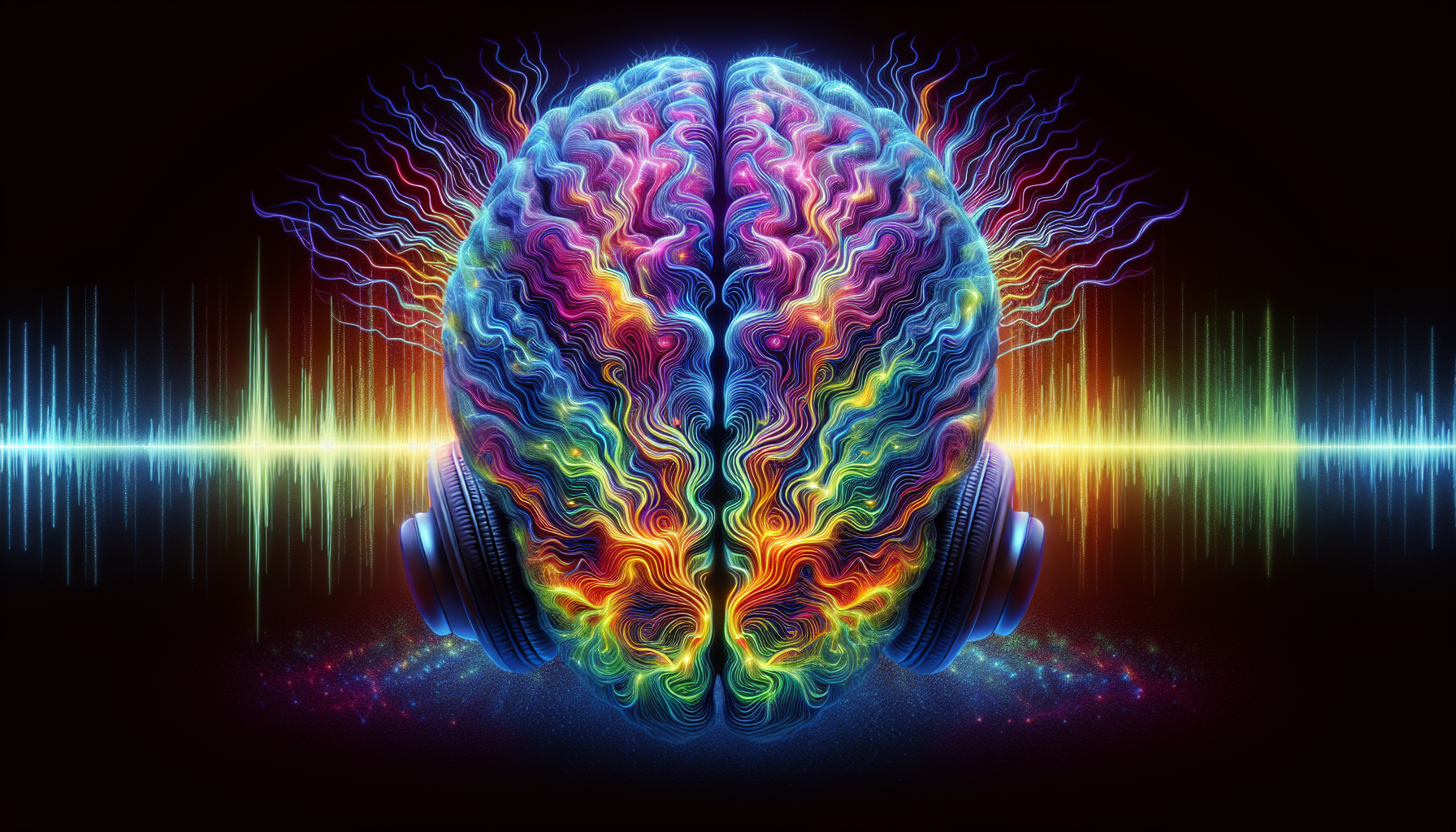On the hunt for meditation music to relax your mind? Look no further. You’ll discover how certain sounds can help you de-stress and concentrate better. This article will take you through the essentials of meditation music, supporting you in your quest for peace without clutter or complexity.
Key Takeaways
-
Meditation music is backed by science, with brainwave entrainment and solfeggio frequencies helping reduce stress, improve sleep, and enhance focus and creativity.
-
Nature sounds like rain, ocean waves, and birdsong are central in meditation music, providing relaxation, stress relief, and improved cognitive performance.
-
The future of meditation music lies in innovations like VR meditation experiences, AI-assisted personalized music generation, and immersive 3D audio soundscapes.
The Science Behind Meditation Music

Ever pondered how certain tunes can induce a state of relaxation and peace? This can be attributed to the science of brainwave entrainment – a technique utilized by meditation music to stimulate various states of consciousness, thus promoting profound relaxation and spiritual exploration. Listening to meditation music has been linked to beneficial changes in brain wave patterns, resulting in reduced stress, improved sleep, and increased focus and concentration.
Research investments are booming in the field of music’s effects on the brain, leading to numerous projects that explore how music can affect the brain and be used as a potential tool for precision medicine. Advanced technologies like artificial intelligence and machine learning are being used to analyze the structure of music and its impact on biometrics, paving the way for the development of therapeutic music that’s targeted and personalized.
Meditation Music on Brain and Cognitive Function
Meditation music influences the brain and cognitive functions by engaging multiple brain structures involved in cognitive, sensorimotor, and emotional processing. Listening to music can activate sensory processes, attention, memory-related processes, perception-action mediation, multisensory integration, and activity changes in core areas of emotional processing, including the processing of musical syntax and musical meaning, as well as social cognition.
Music listening has been shown to activate a multitude of cortical, subcortical, and cerebellar regions across various brain networks, which may explain the enhancement of attention and working memory observed in both healthy and clinical populations.
Furthermore, meditation music has been associated with changes in EEG power and functional connectivity, particularly in the alpha band, indicating alterations in neural networks that lead to enhanced cognitive effects post-exposure to music.
These changes include increased power in the prefrontal and occipital cortex and reduced information flow in long-distance connections between the frontal and parietal cortex, which are associated with intelligence.
Additionally, repeated exposure to long-known music has been shown to affect brain activity and cognitive function in patients with early-stage cognitive decline, suggesting that neuroplastic mechanisms may mediate improvements in cognitive functioning.
The engagement of the brain’s reward system and the release of neurotransmitters and hormones such as dopamine, serotonin, and oxytocin by music also suggest that music affects the chemistry of the brain and activates the reward and prosocial systems.
Brainwave Entrainment
Brainwave entrainment, an intriguing method, employs sound frequencies to synchronize brainwaves with a specific frequency, thereby modifying states of consciousness. This is achieved through methods like binaural beats, isochronic tones, and monaural beats. Ever noticed how certain music can make you feel alert yet relaxed? That’s because music with a rhythm of about 60 beats per minute can cause the brain to synchronize with this tempo, inducing alpha brainwaves associated with relaxation and alertness.
From deep sleep to heightened creativity, a spectrum of brainwave states can be achieved by synchronizing brainwaves to audio signals with distinct beats. Some benefits of using brainwave entrainment include:
-
Improved focus and concentration
-
Reduced stress and anxiety
-
Enhanced relaxation and sleep
-
Increased creativity and problem-solving abilities
-
Heightened spiritual and meditative experiences
Solfeggio Frequencies, used in Gregorian chants, are believed to influence brainwave patterns positively when incorporated into meditation music.
Stress Reduction
The therapeutic power of music extends to stress reduction as well. Music can evoke emotions and alter brain function, significantly reducing stress levels. Physiological effects of music, like expedited recovery of the autonomic nervous system and reduced cortisol levels, aid in stress recovery.
Nevertheless, music’s benefits may not dramatically diminish stress perception or anxiety in the face of an extremely intense stressor. To maximize the stress-reducing effects of music, it’s recommended to combine it with other relaxation techniques like deep breathing or yoga.
Enhanced Focus and Creativity
Beyond relaxation, meditation music can also:
-
Stimulate creativity
-
Specific frequencies, like 417 Hz, can enhance creativity and problem-solving abilities.
-
Natural sounds, such as rain and rainforest ambience, can enhance attention and working memory and foster positive emotions.
Music without lyrics and with a slow tempo can prevent distractions and maintain focus during meditation.
Evidence of The Benefits of Meditation Music
Meditation music has been shown to have several benefits in clinical settings. It can evoke low-arousal positive emotions and pro-social positive emotions during loving-kindness meditation without altering the difficulties associated with the practice.
Additionally, listening to meditative music has been found to significantly reduce state anxiety and heart rate and increase high-frequency norm of heart rate variability in patients during the uptake phase before positron emission tomography scans.
In educational settings, an 8-week program integrating Zen meditation and music listening has been associated with enhanced mindfulness, happiness, and stress management among university music therapy students.
Furthermore, the Society for Integrative Oncology and the American Society of Clinical Oncology have provided guidelines indicating that passive music therapy is recommended to reduce anxiety during radiation therapy, chemotherapy sessions, and post-surgery, based on results from randomized controlled trials.
Exploring Nature Sounds in Meditation Music
Nature sounds are pivotal in meditation music, frequently resulting in heightened relaxation and improved stress alleviation. The soothing symphony of birdsong or the gentle murmur of a flowing stream can transport us to serene settings, far removed from the hustle and bustle of daily life. Regular exposure to nature sounds in meditation music can contribute to long-term resilience to stress and promote feelings of happiness and contentment.
By incorporating these sounds into ambient music, atmospheric soundscapes are created that offer a serene and immersive auditory environment. Think of it as your personal sonic sanctuary, a haven of calm where your mind can find peace and tranquillity.
Rain and Rainforest Sounds
The rhythmic sound of rain coupled with the varied melodies of the rainforest synergistically induce a meditative state, crafting an acoustic environment favourable for relaxation and focus. These natural sounds can mask distracting noises and have a calming white noise quality that assists in achieving deeper states of calm.
From the gentle drizzle to the robust rustle of leaves in a tropical storm, rain-related sounds add depth and richness to the soundscape, enhancing the listening experience. Research has shown that listening to natural sounds like rain can reduce stress and increase feelings of relaxation.
Ocean Waves and Water Sounds
The consistent sounds of the ocean provide ‘acoustic camouflage’ that helps mask other distractions, allowing for a clearer mind and reduced anxieties during meditation. It’s like having a personal beach right at your fingertips, where the rhythmic ebb and flow of the waves wash away your worries.
Birdsong and Forest Ambience
Birdsong in meditation music typically comprises a mix of real recordings and digitally created sounds that replicate the natural sequences heard in the wild. Exposure to birdsong has been shown to reduce stress and enhance cognitive performance, providing a restorative experience for the listener.
Meditation playlists often feature birdsong and forest ambience tracks strategically placed to support focus during meditation practices or to complement periods of rest.
Classical Music for Meditation
The medical literature suggests that classical meditation music may be particularly beneficial for health outcomes. Classical music has been associated with a higher heart rate variability, which is an indicator of the body’s capacity to regulate the heart rate in response to stress.
Additionally, classical music has been shown to facilitate blood pressure recovery from stress.
Meditation music, which may include classical compositions, has been linked to improvements in cardiovascular health, such as reductions in heart rate and cortisol levels after surgery.
The Yellow Brick Cinema Experience

The Yellow Brick Cinema elevates the meditation music experience to unprecedented heights. This platform channels its efforts to provide an auditory experience designed to:
-
Alleviate stress
-
Foster relaxation
-
Rejuvenate
-
Enhance mental wellness
-
Improve sleep quality
-
Enhance concentration
Chakra Balancing and Healing
Yellow Brick Cinema’s Chakra Balancing Music utilizes sound frequencies to align the seven energy centres, or chakras, within the subtle body. These specific sound-healing frequencies, called Solfeggio frequencies, are associated with each chakra and possess unique spiritual and physical healing properties.
Music with these vibrations promotes balance of mind, body, and soul, facilitating the flow of energy.
Mindfulness and Gratitude Meditations
Mindfulness and gratitude meditations are inherent to meditation practice. Both foster awareness of the present moment and cultivate an appreciation for life’s blessings. Incorporating mindfulness and gratitude into daily practice can improve emotional balance and reduce negative feelings.
Meditation music playlists can deepen the experience of mindfulness and gratitude by providing a calming backdrop that enhances concentration on these practices.
Sleep and Relaxation Aids
Moreover, Yellow Brick Cinema provides music specifically designed to help you sit back, relax, and facilitate sleep.
Natural sounds at night, especially the sound of ocean waves, help improve sleep quality by helping individuals fall asleep more quickly and enjoy deeper, more restorative sleep.
How to Incorporate Meditation Music into Your Daily Routine

With an understanding of the benefits of meditation music, you might be curious about how to integrate it into your daily routine. The first step is selecting meditation music that aligns with your personal preferences and establishing a regular time for its practice. This can significantly enhance the overall meditation experience and contribute to stress relief.
Starting with shorter periods of meditation music and progressively increasing the duration can help improve focus and relaxation without overwhelming you.
Setting the Scene
Establishing a dedicated, distraction-free space that encourages relaxation is vital for creating an environment conducive to effective music meditation.
Visual aids such as breathing exercise GIFs can help maintain focus and enhance the meditation experience when coupled with music.
Creating a Routine
Maintaining consistency is key to establishing a meditation music routine and reaping its benefits. A regular schedule for meditation music, with specific times allocated each day, aids in creating a routine.
Experimenting with different music genres is helpful to find what works best for individual relaxation and concentration during meditation, as well as discovering the most relaxing music for your personal practice.
Combining with Other Relaxation Techniques
To maximize the benefits of your meditation music routine, consider combining it with other relaxation techniques. Practising meditation with breathing exercises set to music can enhance relaxation and reduce stress and anxiety.
Upbeat music can also improve concentration and foster a more positive and optimistic outlook on life.
Top Platforms to Discover and Listen to Meditation Music
We live in a digital age where relaxation is just a click away. Subscription-based platforms have become a popular way to access meditation music, catering to users who are looking for a diverse collection of meditation and relaxation content. In addition to music, these platforms offer more than just music; they provide users with guided sessions and various other relaxation tools to enhance the meditation experience.
YouTube
YouTube, for instance, offers a diverse selection of free meditation music videos for users seeking relaxation and focus. From nature sounds to guided meditations, you’ll find a wide variety of options to match your mood and preferences. Simply download your favourite videos and enjoy the soothing sounds of nature and meditation.
Spotify
Spotify takes it a notch higher by providing an AI Playlist feature that allows for the generation of personalized playlists. Subscribers can provide prompts specifying desired genres, moods, artists, or time periods, and Spotify will create a playlist just for them.
Apple Music
Apple Music, too, provides an extensive library of music, including a unique catalogue of meditation and relaxation tracks that music experts curate. Some popular Apple Music playlists created for meditation and concentration include ‘Mindfulness,’ ‘Pure Calm,’ and ‘Pure Focus’.
SoundCloud
SoundCloud features a variety of meditation music tracks and playlists, contributing to the platform’s vast library of music and sounds. Whether you’re looking for ambient sounds, nature sounds, or guided meditations, SoundCloud has you covered.
Customizing Your Meditation Music Experience
Creating a personalized meditation music playlist involves selecting music that resonates with the individual to facilitate relaxation, self-reflection, and emotional well-being. This section provides guidance on identifying personal goals, choosing the right sounds and genres, and adjusting the length and tempo of meditation music.
Identifying Your Goals
Creating an effective meditation music playlist begins by establishing personal objectives such as relaxation, focus, or emotional healing. The most impactful meditation music is often subjective, deeply resonating emotionally and providing a conduit for introspection and self-expression.
Choosing the Right Sounds and Genres
Selecting the right sounds and genres is a key part of customizing your meditation music experience. A range of music genres, including:
-
classical
-
ambient
-
jazz
-
post-rock
-
world fusion
are all suitable for meditation. Each genre offers a unique experience that can influence different emotions and aspects of well-being, serving distinct meditation goals.
Adjusting the Length and Tempo
Considering your personal needs and preferences, you might want to tweak the duration and speed of your meditation music. Background scenes for meditation can be selected and changed within a meditation app, providing the option to enhance the meditation environment.
The volume of background sounds in meditation apps can be personalized, tailoring the meditation experience to individual preferences.
The Future of Meditation Music: Trends and Innovations
Looking ahead to the future of meditation music, a cultural shift is apparent. Music is increasingly adopted as a wellness tool, irrespective of the artist or genre. Streaming platforms are witnessing new patterns of consumption where listeners use music as a wellness tool. This has incentivized further developments in meditation music technologies such as virtual reality experiences, artificial intelligence compositions, and immersive 3D audio soundscapes.
Virtual Reality Meditation Experiences
Virtual reality meditation utilizes immersive technology to craft tranquil environments, thus augmenting mindfulness practice with serene settings like forests or beaches. Applications like TRIPP provide guided meditations in a VR format to promote focused attention by eliminating outside visual stimuli.
Live music within virtual reality can incorporate brainwave entrainment, allowing participants to journey through different states of consciousness.
Artificial Intelligence and Music Generation
Artificial intelligence has profoundly influenced the music industry by presenting a tailor-made alternative to traditional music composition. It is both quicker and more cost-efficient. AI-generated music can be composed in mere minutes, a timeframe much shorter than traditional methods, meeting the demands for quick production in meditation music.
With tools like Spotify’s AI Playlist, listeners can tailor their meditation music based on their desired mood or activity, thus enhancing their meditation experience through personalization.
Immersive Soundscapes and 3D Audio
The integration of immersive soundscapes and 3D audio into meditation music serves to enrich the listener’s experience. New music listening centers and ‘listening bars’ dedicated to providing immersive audio experiences are gaining popularity. These immersive environments are sought after for meditation and wellbeing, signifying their importance in the relaxation and focus enhancement.
Summary
In this exploration of meditation music, we’ve journeyed through the science behind it, the role of nature sounds, and the unique offerings of platforms like Yellow Brick Cinema. We’ve provided practical tips for incorporating meditation music into your daily routine and personalizing your experience. Lastly, we’ve glimpsed into the exciting future of meditation music with trends like virtual reality, AI compositions, and 3D audio. We hope this knowledge empowers you to dive into the serene world of meditation music and reap its manifold benefits.
Frequently Asked Questions
What is brainwave entrainment in meditation music?
Brainwave entrainment in meditation music is a technique that uses sound frequencies to align brainwaves with a desired frequency. It alters states of consciousness and induces different states, from relaxation to heightened creativity. It’s a powerful tool that can enhance meditation practice.
How does meditation music aid in stress reduction?
Meditation music aids in stress reduction by evoking emotions, altering brain function, and providing physiological effects that expedite recovery of the autonomic nervous system and reduce cortisol levels. So, incorporating meditation music into your routine can be a helpful tool for managing stress.
How can I incorporate meditation music into my daily routine?
Create a dedicated space for meditation, establish a regular schedule, and combine it with other relaxation techniques to easily incorporate meditation music into your daily routine. This way, you’ll be able to enjoy the mental and emotional benefits of meditation music on a daily basis.
How can I customize my meditation music experience?
To customize your meditation music experience, identify your goals, select suitable sounds and genres, and adjust the length and tempo of the music to align with your preferences. Enjoy your personalized meditation journey!
What trends and innovations are emerging in meditation music?
Meditation music is evolving with trends such as virtual reality experiences, artificial intelligence compositions, and immersive 3D audio soundscapes, offering a more immersive and personalized meditative experience.
Disclaimer: This article is for informational purposes only and should not replace professional medical advice. If you have specific concerns or medical conditions, it is recommended to consult with a healthcare professional for personalised guidance and support.
Resources
The Effects of Music on the Cardiovascular System and Cardiovascular Health.
Trappe HJ.
Heart (British Cardiac Society). 2010;96(23):1868-71.
Hwang MH, Bunt L, Warner C.
International Journal of Environmental Research and Public Health. 2023;20(23):7140.
Tang Q, Han J, Zeng X.
Behavioral Sciences (Basel, Switzerland). 2024;14(3):204.
Henneghan AM, Becker H, Phillips C, Kesler S.
Journal of Psychosomatic Research. 2021;150:110628.
Effects of Mindfulness Meditation on Musical Aesthetic Emotion Processing.
Liu X, Liu Y, Shi H, Zheng M.
Frontiers in Psychology. 2021;12:648062.
The Best Meditation Apps for Achieving Better Sleep.






